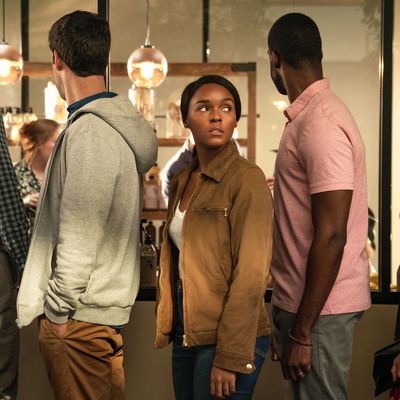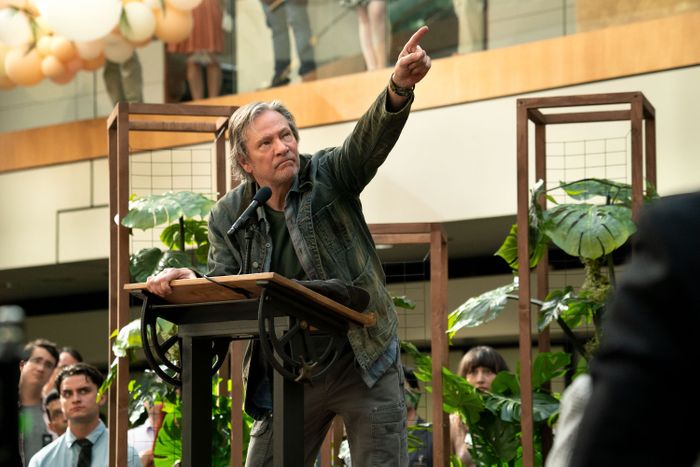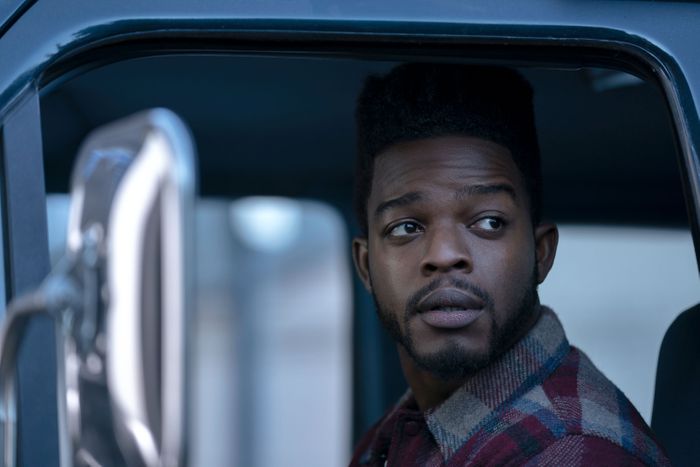
Spoilers below for Homecoming seasons one and two.
The mid-credits scene in Homecoming’s first-season finale offered a big moment in the life of a minor character. Up until then, Audrey Temple, played by powerhouse Hong Chau, was a lowly receptionist at Geist, the company that was secretly testing an experimental memory-erasing drug on military veterans. But in those final moments, Audrey turned the tables on Bobby Cannavale’s Colin Belfast, setting him up to take the fall for the ensuing scandal and revealing herself as a newly promoted Geist bigwig.
But was she, really? The second season explains this surprising turn of events — and then some — in a story that features Janelle Monáe as Homecoming’s new lead and puts Audrey’s finale twist in a different light. Although co-showrunners Micah Bloomberg and Eli Horowitz had not worked out the entire plot for the second season when they finished production on the first cycle, they knew she would be a focal point. “When we were shooting that final scene with Audrey and Colin, we were able to tell Hong that Audrey was bluffing,” Bloomberg said. “But as far as her personal life and what would become the emotional crisis, we didn’t have any of that.”
Exploring how a receptionist managed to climb the ranks at an evil corporation, and how exactly she’s related to Monáe’s enigmatic character, plays out like a psychological thriller. The season, which dropped on Amazon Prime Video on Friday, also features Stephan James reprising Walter Cruz, one of the victims of Geist’s Homecoming program, Chris Cooper as Leonard Geist, and Joan Cusack as a scheming military officer.
Bloomberg and Horowitz spoke with Vulture about continuing their story without the guidepost of their popular podcast, working with Janelle Monáe and Hong Chau, and why they left the story open-ended again. “What we try to do is make each season tell a complete story and resolve itself,” Bloomberg said, “but also leave enough windows and trapdoors open so that there’s new things to explore.”
Without the podcast to rely on, how did you approach creating a story from scratch this time around?
Micah Bloomberg: We knew pretty early that we were going to leave the material that we generated from the podcast and strike off in a new direction. We wanted to get more into the Geist world, we knew that Temple was going to be an important part of season two, and we knew there was more to her story than we had said explicitly in season one. And then once we got into Janelle’s character and figured out her predicament — once those things started to combine and lock together — we knew the general thrust of what we were going to be heading for.
Eli Horowitz: The podcast was so much an audio creation, even the way we thought about the scenes and the characters. Obviously, that evolved into the television version of season one. But it still had those fingerprints all over it, for better and worse, sometimes in ways we didn’t even realize until halfway through shooting. When we started this season, we were able to start with a blank canvas, which let us be more expansive in our settings and more kinetic and dynamic. It wasn’t so locked down with two people in a room. We were able to paint with a bigger brush on a bigger canvas.
The first-season finale ended with a scene that focused on Audrey Temple, someone who had been a minor character until then. What was it about Audrey that you found compelling, and had you already developed much of her story at that point?
Bloomberg: We knew that she would be an important part of it, but we didn’t know exactly how. I enjoy the parallels between people in the story overlooking her and the viewers also, maybe, overlooking her. The shock for Colin might mirror the shock for our viewers. She was almost like a quirky extra last season, and she really steps forward and becomes an indelible character. That was an exciting way of launching the new season. In the writing of season two, we connected [her with] the story of the Jackie character. Their dynamic — how it’s tender in some ways, and unhealthy in others or a bit twisted — that became the emotional crux of the season.
What were you looking for in an actor to play Jackie? And how did you cast Janelle Monáe?
Bloomberg: Without saying too much, because there’s obviously a twist at the heart of the story, this is a character who takes on different identities and different personas. We wanted an actress who could have that chameleonic quality, who could really, fully embody all these different people. The character is not that great of a person, by any means. We needed someone who would be instantly compelling and vulnerable when you first see her, but who would also keep you on her side, caring about her the more you learn about all the other things she’s done. Vulnerability, changeability, and just a compelling presence is a rare mixture and, of course, Janelle has all those things to the extreme.
We had talked about Janelle in season one, so she was on our list of potential cast then but it didn’t work out. For season two, timing-wise and as far as her career trajectory taking more acting roles, I think it was right. We see a parallel between Janelle’s ability as a media presence and performer — to take on all these different roles and be a chameleon — as fitting in an interesting way with her character. The other thing was that Janelle can physically embody the tension or interest of a scene. She’s such a visual performer, and we were really interested in having season two be more visual. Kyle Patrick Alvarez, the director, was a great partner in that.
What excited you about watching Janelle and Hong working together?
Horowitz: The characters are obviously so different, and they’re also so different as performers. Janelle and her character are always pushing things forward, and Hong and Audrey are more watchful and evaluating. I think that is what adds the fun energy, but I’m not smart or experienced enough to calculate something like that. You just have to write the scenes the best you can, take actors who can tackle it, and then you just hope for the best.
Did you know from the beginning that you wanted Audrey’s partner to be a woman?
Bloomberg: What I remember is that we had this cool character of Jackie, who had fallen for her own cover. We were developing her as a woman, and when we put that part of the story together with Hong, we were like, “Oh, I guess they’re a lesbian couple, that’s interesting.” It happened when we connected the two pieces and it was interesting for us to not shy away from that, not try to flip her gender. It gave the season more texture.
Tell me about casting Chris Cooper as the mysterious Mr. Geist.
Horowitz: He was the first person we asked for that part. We knew all along that we wanted Leonard Geist to be as far as possible from the expectations of the CEO mastermind who is seven moves ahead. Chris has such a vulnerability about him, and there’s a sweetness, but he can also obviously play cantankerous. He’s just so devoted. We knew there wouldn’t be any shying away from the warts of the character. He was just a dream to work with — so focused, so diligent, and loyal to the other actors.
His scenes with Joan Cusack are exceptional, especially in the finale. She accepts her fate easily, and seems to even admire what Geist did.
Bloomberg: When you have those two actors, you get a chance to step back and just watch them work a little bit more. It’s maybe not a scene that is 100 percent narratively necessary. But for these two performers, it was too good an opportunity to pass up to have them meet each other near the end of the story. It’s one of my favorite scenes of the season because it has all these different colors and emotions that are unexpected. It was just a total pleasure to watch them rip into it that way. He got her, basically, and game respects game, as they say. She has to tip her hat off to him because he pulled out the rug from under her. That’s just how it goes. Just gotta lie back in the dirt and wait.
Were Sam Esmail and Julia Roberts involved in season two?
Bloomberg: They surprised us on set one day. We were sitting at the monitors, shooting a scene, and I looked at the camera and I was like, “What Julia Roberts movie did they put on the monitor for some reason?” But then we realized they were physically sitting at the set that we were shooting at. It was a practical joke. That was really funny and made the day pretty exciting. But Sam has been a great creative partner with us throughout the show and an amazing resource whenever we want to talk. Julia and her company have been long-standing supporters, from the podcast through the TV show.
Horowitz: Something that I think that Kyle did really well was take that distinctive visual language that Sam set up in season one and use it, but not feel confined by it, not try to re-create it.
Had either one of you worked with Kyle before?
Horowitz: No. He came in and pitched his vision for the season, and we were blown away by the specific insights that he had. He really saw the role of nature in this season, that people were out in nature much more than season one. [Monáe’s character] is lost in this forest that dwarfs her, but then within Geist headquarters they’re containing and simulating nature, and then you have the middle world of the farm. Beyond that, he just had this tremendous energy and enthusiasm. That’s the biggest parallel between him and Sam, beyond any specific references or shooting styles. It’s just that drive to really make every shot count.
Bloomberg: There’s a scene where Jackie breaks into Audrey Temple’s house and there’s more going on there, obviously. It’s a cool second-watch opportunity. When we wrote it, we thought of it as an interesting, tense moment. Kyle saw it as an opportunity to do what we call some “bravura filmmaking” and pick up Sam’s mantle and pull out all the stops. On some shows when they pull out all the stops, they’re talking about spaceships exploding. For us, it’s relatively low-key, but I remember Kyle planning out that sequence and how it was all going to tie together and when we watched it in edit we were very impressed by how long he could maintain that shot and the complexity that he worked into the situation. She pulls up in her car, and it’s one long, unbroken shot, all the way to her getting back into the car and chasing Temple up the street.
Walter has changed a bit this season, too. Did you see any differences in Stephan James as an actor this time around?
Horowitz: We did! In season one, we talked about Walter as almost a damsel in distress. He’s so earnest and trusting and you care for him. He embodied that in a great way, but Walter is the one who doesn’t know what’s going on and everyone else is trying to maneuver around him. In season two, we wanted him to have more agency and also more anger, which, of course, is justified after what his character went through. Stephan was excited about that from the moment we told him. He’s just such a pro. Every day, he was so prepared and so ready, such a steady presence.
So, is Walter heading to Florida next? He’s last seen driving away with some files about Homecoming.
Bloomberg: Hmm. You know, there’s a couple of different things on that list. There’s the guys from the [Homecoming] program, God knows where they are. And there is Heidi at the top. But, like last season, we’re enjoying presenting something that can be read in multiple ways.
You showed us that scene from the first-season finale again, after Walter has seen Heidi and it makes you wonder again if he remembers something. It seems he does. Do you want to clear this up?
Horowitz: It seems that it’s somewhere in there, right? There’s something we talked about, even just as we tease out plot development and lines and scenes, and that is that there’s all these kinds of memories. There’s actual memory. There’s physical memory. There’s what we call “in your bones” memory, that’s just about who you are. And there’s also the sense of what happens when these two specific individuals get together. It’s almost like when you connect with an ex and you fall into patterns. It’s not even necessarily because of memories. It’s just who you are and who this other person is and the strange reaction that happens when those are brought together. And so, even among the two of us, we’ve probably had different interpretations of that scene. But I think there’s a lot more possibilities than just “he remembers the whole thing” or “he remembers nothing” because clearly there’s something going on. It’s not just a yes or no thing.
Who was the brilliant person that found Nina Simone’s version of “My Way” for the very end of the season? I had never heard that.
Bloomberg: Our editor Matt Ramsey was riding home one night listening to a collection of covers that he had on Spotify. He came in and he said, “I have a crazy idea.” We were like, “Yeah, this is the perfect mix of unexpected and strange and the song is familiar yet Nina Simone’s performance is so distinct.”
Without spoiling the end of the season, you do leave some loose ends. Will we see these same characters again if you produce a third season?
Bloomberg: What we try to do is make each season tell a complete story and resolve itself, but also leave enough windows and trapdoors open so that there’s new things to explore that don’t necessarily flow in an unexpected way. Once you see them, it feels natural and connected — that’s the goal, at least. So, yes, we have our windows and trap doors available to us and we know what lies beyond a few of them. Is that vague enough to be meaningless? [Laughs.]



